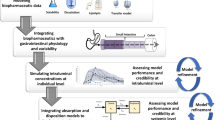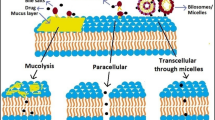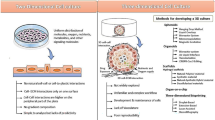Abstract
Purpose. To improve predictions of fraction dose absorbed (Fa) for hydrophilic drugs, a correction of paracellular permeability using the pore radius of tight junctions (TJs) in Caco-2 monolayers was performed.
Methods. The apparent permeability coefficient (Papp) of drugs was measured using the Caco-2 assay and the parallel artificial membrane permeation assay (PAMPA), and values were corrected with the pore radius of TJs.
Results. An equation for calculating the pore radius of TJs from the Papp of lucifer yellow was obtained. The optimal pore radius of TJs in Caco-2 monolayers for predicting human Fa was calculated to be 7 Å. The correlation between the actual and predicted Fa was improved by using the Papp corrected with the pore radius of TJs. Permeability in the PAMPA, which was corrected using the pore radius and membrane potential, was well correlated with that in the Caco-2 assay. Most of the hydrophilic drugs tested in this study were absorbed mainly through the paracellular pathway.
Conclusions. The results suggest the necessity of optimizing paracellular permeation for the prediction of Fa, and also the importance of the paracellular pathway to the absorption of hydrophilic drugs. This method might contribute to the setting of appropriate dosages and the development of hydrophilic drugs.
Similar content being viewed by others
references
H. Bohets, P. Annaert, G. Mannens, L. V. Beijsterveldt, K. Anciaux, P. Verboven, W. Meuldermans, and K. Lavrijsen. Strategies for absorption screening in drug discovery and development. Curr. Top. Med. Chem. 5:367-383 (2001).
P. Wils, A. Warnery, V. Phung-Ba, S. Legrain, and D. Scherman. High lipophilicity decreases drug transport across intestinal epithelial cells. J. Pharmacol. Exp. Ther. 269:654-658 (1994).
K. Sugano, N. Takata, M. Machida, K. Saitoh, and K. Terada. Prediction of passive intestinal absorption using bio-mimetic artificial membrane permeation assay and the paracellular pathway model. Int. J. Pharm. 241:241-251 (2002).
Y. L. He, S. Murby, G. Warhurst, L. Gifford, D. Walker, J. Ayrton, R. Eastmond, and M. Rowland. Species differences in size discrimination in the paracellular pathway reflected by oral bioavailability of poly(ethylene glycol) and D-peptides. J. Pharm. Sci. 87:626-633 (1998).
I. J. Hidalgo, T. J. Raub, and R. T. Borchardt. Characterization of the human colon carcinoma cell line (Caco-2) as a model system for intestinal epithelial permeability. Gastroenterology 96:736-749 (1989).
P. Artursson, K. Palm, and K. Luthman. Caco-2 monolayers in experimental and theoretical predictions of drug transport. Adv. Drug Deliv. Rev. 46:27-43 (2001).
S. Yamashita, T. Furubayashi, M. Kataoka, T. Sakane, H. Sezaki, and H. Tokuda. Optimized conditions for prediction of intestinal drug permeability using Caco-2 cells. Eur. J. Pharm. Sci. 3:195-204 (2000).
G. T. Knipp, N. F. H. Ho, C. L. Barsuhn, and R. T. Borchardt. Paracellular diffusion in Caco-2 cell monolayers: effect of perturbation on the transport of hydrophilic compounds that vary in charge and size. J. Pharm. Sci. 86:1105-1110 (1997).
A. Adson, T. J. Raub, P. S. Burton, C. L. Barsuhn, A. R. Hilgers, K. L. Audus, and N. F. H. Ho. Quantitative approaches to delineate paracellular diffusion in cultured epithelial cell monolayers. J. Pharm. Sci. 83:1529-1536 (1994).
F. E. Curry. Handbook of physiology. In E. M. Renkin and C. C. Michel (eds.), The Cardiovascular System, American Physiology Society, Bethesda, MD, 1984, pp. 309-374.
K. Sugano, H. Hamada, M. Machida, H. Ushio, K. Saitoh, and K. Terada. Optimized conditions of bio-mimetic artificial membrane permeation assay. Int. J. Pharm. 228:181-188 (2001).
G. L. Amidon, P. J. Sinko, and D. Fleisher. Estimating human oral fraction dose absorbed, a correlation using rat intestinal membrane permeability for passive and carrier-mediated compounds. Pharm. Res. 5:651-654 (1988).
J. S. Fordtran, F. C. Rector, Jr., M. F. Ewton, and N. Soter. and J. Kinney. Permeability characteristics of the human small intestine. J. Clin. Invest. 44:1935-1944 (1965).
K. H. Soergel, G. E. Whalen, and J. A. Harris. Passive movement of water and sodium across the human small intestinal mucosa. J. Appl. Physiol. 24:40-48 (1968).
M. E. Dowty and C. R. Dietsch. Improved prediction of in vivo peroral absorption from in vitro intestinal permeability using an internal standard to control for intra-and inter-rat variability. Pharm. Res. 14:1792-1797 (1997).
C. Zhu. L Jiang, T. M. Chen, and K. K. Hwang. A comparative study of artificial membrane permeability assay for high throughput profiling of drug absorption potential. Eur. J. Med. Chem. 37:399-407 (2002).
N. C. Sambol, L. G. Brookers, J. Chiang, A. M. Goodman, E. T. Lin, C. Y. Liu, and L. Z. Benet. Food intake and dosage level, but not tablet vs solution dosage form, affect the absorption of metformin HCl in man. Br. J. Clin. Pharmacol. 42:510-512 (1996).
K. Seiga, M. Minakawa, K. Miyoshi, K. Yamaji, and Y. Sugiyama. Studies on cefazolin. 2. Primary clinical trial by oral administration. Jpn. J. Antibiot. 25:28-30 (1972).
E. S. Rattie and L. J. Ravin. Pharmacokinetic interpretation of blood levels and urinary excretion data for cefazolin and cephalothin after intravenous and intramuscular administration in humans. Antimicrob. Agents Chemother. 7:606-613 (1975).
Author information
Authors and Affiliations
Corresponding author
Rights and permissions
About this article
Cite this article
Saitoh, R., Sugano, K., Takata, N. et al. Correction of Permeability with Pore Radius of Tight Junctions in Caco-2 Monolayers Improves the Prediction of the Dose Fraction of Hydrophilic Drugs Absorbed by Humans. Pharm Res 21, 749–755 (2004). https://doi.org/10.1023/B:PHAM.0000026423.48583.e2
Issue Date:
DOI: https://doi.org/10.1023/B:PHAM.0000026423.48583.e2




